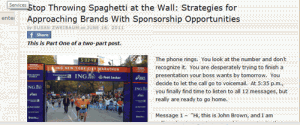You hear it over and over again during board meetings at synagogues and churches: “How do we get more members, and how do we make sure that our congregants pay their full dues, tithe, contribute at Sunday services?”
These are important questions, but the problem is they approach the problem from the wrong perspective. Board members are looking at the situation from the inside-out, from their perspective. They see the issues of dwindling membership and dues and giving growth as something they need to fix by simply changing the dues structure, giving approach or by advertising more.
If the boards looked at the issue from the outside-in perspective, they instead would ask themselves these questions: “What about the experience of joining or being a member does not appeal to the community, and how can we improve the experience so that we are a welcoming place that fulfills the needs of these prospective members?”

The reality is you need to understand the full journey the members are taking and what they want their ideal experience to look like, so that you can create an institution the prospective members want to be a part of.
Religious institutions of the past, with their dues or giving structure, religious services and focused on a central building, do not necessarily appeal to members of the millennial, Gen-Y and Gen-Z generations. These younger generations crave spirituality, but don’t want the same experiences as their parents or grandparents. As a result, many synagogues and churches struggle to figure out how to change and provide these new generations what they want and need, while not alienating their existing congregants.
Congregations need to think differently about how their institution looks to those outside of it. The simple truth is that these generations view all their experiences through a new lens. According to PwC, among all customers, 73% point to experience as an important factor in their purchasing decisions, behind price and product quality. We need to remember that this mentality crosses all of their purchases, whether it is a new pair of jeans, a new car or membership in a religious institution.
One way to begin to answer this bigger question of how to change is to utilize the discipline of Customer Experience. Customer experience is the “the perceptions and feeling a customer has of the sum total of all touchpoints and experiences they have with your company, product or service.” It isn’t one single interaction, but all of them put together. By looking at the entire journey and pinpointing the areas that are most important to the target audience religious institutions may be able to solve this growth dilemma.
To get started we need to look at the main elements of Customer Experience and how they can be applied to the issues facing religious organizations.
Use the Voice of the Congregant
Understanding how your future or current congregants feel about their experience is key to building the best experiences. This critical research, gained both through surveys and interviews, should get to what they are thinking, feeling and doing with regards to participation and how that does or doesn’t meet their actual needs. The key is to get to empathic conclusions that help you understand what the target member’s ideal experience looks so you can make more than incremental changes.
Many congregations currently make small, incremental changes to their dues structure, holiday services, etc. based on what they think the needs are or what just a few voices say. This is helpful, but you are only adjusting the current experience. The real changes come when you use that voice of the congregant to envision something completely new that draws from that ideal experience. For example, you find out people feel your services are boring and don’t want to attend. You can adjust the current services by adding new and lively music or you can completely reinvent your services in a way that draws people in for an entirely new experience.Do you conduct the service somewhere else, like a park or beach, or do you let the congregants lead instead of the clergy?
Map Out the Experience
Taking the information gleaned from interviews and surveys provides you with the basis to map out the end-to-end journey, starting from the point where they are looking to engage with a religious institution all the way through to where they are longstanding members. You also can look at micro-journeys, such as the process to becoming a bar/bat mitzvah or being confirmed. This mapping allows you to review all the touchpoints in that journey, looking at what the current and future members go through vs. what they envision their ideal vision of those touchpoints to be. Utilizing a cross-section of your congregants, board, and religious and lay staff will provide rich insights for a journey map that will begin to identify where changes are most needed.

It is likely those participating in the journey-mapping workshops will have many aha’s as new insights are revealed and the key moments that matter most to the congregants are identified. By identifying the moments and their level of importance to the future and current members, the congregation can better prioritize where to focus. This is the point where you also layer in the overall resources and financial considerations of the congregation.
Develop Solutions
Once you have mapped out the experience and identified where to place the focus for change, you can develop new and innovative solutions that result in this improved experience. Again, using a cross-section of congregants, lay people and clergy will provide richer ideas. Using the design-thinking approach, which focuses solution building on the people you are designing for and includes empathy, ideation and experimentation as its core pillars, you will be able to create opportunities that are completely new and address the needs of those you are targeting. For instance, you determine that you have a very digitally engaged audience that has no interest in going to your website because they are so app driven. Through the use of design-thinking, you determine you need to create an app with key dates and a quick way to sign up for events.

Measure Success
The final step is to assign metrics to your solutions to determine your ongoing success (or failure) so you can continually adapt and ensure you are meeting your goals. If a solution is to create an app, then you need to set goals for downloads, usage, etc. If it isn’t working, find out why, adjust and measure again. Otherwise, the mapping and solutions development become something used once and put on a shelf. That map and the solutions coming from the efforts should be ever-evolving, just like the institution itself.
By utilizing customer experience methodologies to better understand the needs and desires of your congregants and creating solutions that are developed to address those specific needs you will be one step closer to growing and maintaining a vibrant and engaged community.

